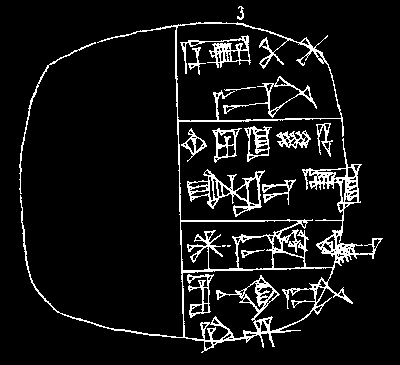Anshe's Tablet Collection
My old donkey Anshe has collected tablets providing information on the non-human inhabitants of Nippur and the surrounding areas. This ancient tablet was drafted some time between 2375 B.C. and 2355 B.C., not very long before the rise to power of the great King Sargon of Agade. This tablet is not from Nippur, but was retrieved from Girsu (modern Tello), one of the major cities of the kingdom of Lagash. The trip from Nippur to Girsu covers a distance of over 100 kilometers, not a difficult journey for an enterprising equid. Translation and explanation of the tablet follow below.
|
Column One
16 še
gur
sag-gál
še anše
kú
LAK 483-si-ga
gana2-DÙN.ÚH-
ka-kam |  |
Column Two
lugal-
mas-su
sag-apin
-na-ra
en-ig-gal
nu-banda
|
After the scribe used up the obverse or front of the tablet with two columns, he flipped the tablet vertically, not horizontally the way we would turn the page of a book. Then, on the reverse, he started on the right rather than left column. For this transaction, he did not need to write anything on the last column.
|
Column Four
Column
Blank |  |
Column Three
ganun-PAP.PAP
-ta
iti-udu-šè-še-a-
íl-la
dnanše-ka
e-na-ta-
gar II
|
What the Tablet Says
The tablet can be translated: Eniggal, the supervisor, has delivered from the warehouse of the PAP.PAP, (about) 931 liters (or: about 245 gallons) of barley grain, barley for the feeding of the donkeys, to Lugal-massu, the plough manager, in connection with the ploughing of the field Gana-DUN.UH, in the month of Carrying Grain and Water to the Sheep for Nanshe, second year.
What the Scribe Wrote
- The accent marks and subscript in the transliteration are a convention used to distinguish cuneiform signs with the same pronunciation, but different meaning.
- The superscripts are the way we represent determinatives (word classifiers). Names of deities are frequently preceded by the asterisk-looking divine symbol d.
- Cuneiform signs often have more than one reading or pronunciation depending on the meaning. When we can't figure out the appropriate reading for a sign or group of signs, we leave them in capital letters, as at the end of Column One and beginning of Column Three. When we are totally in the dark about a sign, we use a serial number to refer to it, for example LAK 483.
Learning Some Words
- še "barley grain"
- anše "donkey"
- kú "eat, feeding"
- LAK 483-si-ga "ploughing," although we don't know how to read the sign, there is evidence for its meaning
- sag-apin "plough manager" (sag means "head" or "chief")
- nu-banda "supervisor"
- ganun "warehouse, storage facility"
- PAP.PAP reading and exact translation uncertain, but the expression is used as a title of Baranamtara, wife of the city ruler Lugalanda
- iti "month"
- udu "sheep"
- a "water"
- íl "carry, lift, bear"
- gar "place, deliver"
This hand copy is taken from Wilhelm Förtsch, Altbabylonische Wirtschaftstexte aus der Zeit Lugalanda's und Urukagine's: Vorderasiatische Schriftdenkmäler der königlichen Museen zu Berlin, Heft XIV. Leipzig: J.C. Hinrichs'sche Buchhandlung, 1916. Text No. 49. These texts are actually from the Presargonic period. We no longer use the expression Old Babylonian or Altbabylonische to refer to this early period.
The text has been edited (in German) by Josef Bauer, Altsumerische Wirtschaftstexte aus Lagasch: Studia Pohl, Vol. 9. Rome: Biblical Institute Press, 1972. Pp. 123-125.
Click on these links to navigate our site:
- Return to Anshe's Room to learn more about the non-human inhabitants of Nippur.
- To find the most official point of view from the great king, enter the Royal Display Room.
- To see Nippur through the eyes of explorer and excavator John Punnett Peters, first modern archaeologist at Nippur, visit our Earth-Moving Room.
- To help visualize the location and layout of Nippur, visit the Map Room.
- To learn more about ancient Nippur, discover the resources in the Reading Room, or study the bigger picture of cuneiform culture at the Reading Room's Cultural Annex.
- To get an overview of Nippur, go to the Broad Vista Room.
- To evaluate the specialization of labor and professionalism at ancient Nippur, take a look in the Professional Room.
- To sneak up for a close look at "the establishment," step into the Establishment Room.
- After you have wandered through the rooms of Dubsar's abode, try your hand at the Nippur Quiz. JavaScript required. Two levels now available.
- Return to the home page of Dubsar, the Cuneiform Scribe.



This page was edited on 26 April 1999. If you have cuneiform questions or comments, please email Dubsar, the Cuneiform Scribe. If I do not respond promptly, the vendor supplying Fortune City's email service may be eating your mail for lunch. In that case, you can give a shout over to Dubsar's Sand Dune to get my attention. Thanks! © 1998-1999 Erasmus Compositor, P.O. Box 25958, Baltimore, MD 21224.


